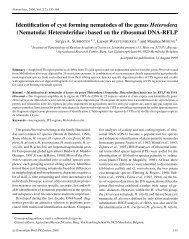Description of Tylenchulus musicola sp. n. (Nematoda ...
Description of Tylenchulus musicola sp. n. (Nematoda ...
Description of Tylenchulus musicola sp. n. (Nematoda ...
Create successful ePaper yourself
Turn your PDF publications into a flip-book with our unique Google optimized e-Paper software.
Z. Tanha Maafi et al.<br />
logical analysis <strong>of</strong> <strong>Tylenchulus</strong> populations from different<br />
hosts revealed the presence <strong>of</strong> other <strong>sp</strong>ecies. <strong>Tylenchulus</strong><br />
furcus was described in South Africa from sugarcane,<br />
Saccharum hybrid plants and poorly growing grass on a<br />
golf course (Van den Berg & Spaull, 1982). Previously<br />
known as a grass race and a bush race <strong>of</strong> the citrus root<br />
nematode, T. graminis and T. palustris, re<strong>sp</strong>ectively, were<br />
described from native plants in Florida, USA (Inserra et<br />
al., 1988a, b). Later, T. palustris was also found infecting<br />
peach in Alabama, Arkansas, Georgia and Virginia<br />
and some non-cultivated plants including sea oxeye (Borrichia<br />
arborescens and B. frutescens) along the shorelines<br />
<strong>of</strong> Florida and Bermuda (Dow et al., 1990; Inserra et al.,<br />
1990; Eisenback & Reaver, 2007).<br />
During a survey <strong>of</strong> plant-parasitic nematodes in banana<br />
plantations in Zarabad, Sistan and Blouchestan province,<br />
south-east Iran, a <strong>Tylenchulus</strong> population was isolated<br />
from soil and roots <strong>of</strong> banana plants. Preliminary morphological<br />
and molecular analyses showed that the population<br />
differs from all four <strong>of</strong> the described <strong>sp</strong>ecies <strong>of</strong><br />
<strong>Tylenchulus</strong> and represents a new <strong>sp</strong>ecies. The presence<br />
<strong>of</strong> tylenchulid second-stage juveniles (J2) in soil samples<br />
collected in banana plantations has been reported<br />
in Venezuela (Haddad et al., 1975) and Burkina Faso<br />
(Sawadogo et al., 2001), although the ability <strong>of</strong> these nematodes<br />
to infect banana roots was not ascertained.<br />
The present diagnostics <strong>of</strong> <strong>Tylenchulus</strong> <strong>sp</strong>ecies is based<br />
on the analysis <strong>of</strong> a few morphological characters <strong>of</strong> the<br />
male, mature female and J2 (Inserra et al., 1988a, c, 1994)<br />
and requires taxonomic expertise. <strong>Tylenchulus</strong> J2 could be<br />
easily misidentified with J2 <strong>of</strong> the closely related genera<br />
Sphaeronema, Trophonema and Trophotylenchulus, or<br />
even with those <strong>of</strong> root-knot nematodes, Meloidogyne <strong>sp</strong>p.<br />
Identification procedures might also be complicated by<br />
the presence <strong>of</strong> several <strong>Tylenchulus</strong> <strong>sp</strong>ecies in a sample.<br />
For example, T. semipenetrans was found to occur in soil<br />
in association with other <strong>Tylenchulus</strong> <strong>sp</strong>ecies in Florida<br />
(Inserra et al., 1994) and with the new <strong>Tylenchulus</strong> <strong>sp</strong>ecies<br />
parasitising banana roots in Iran. <strong>Tylenchulus</strong> graminis<br />
and T. palustris are <strong>of</strong>ten found together in some native<br />
areas in Florida.<br />
Wang et al. (2004) and Park et al. (2009) developed<br />
a diagnostic PCR-ITS-RFLP pr<strong>of</strong>ile for T. semipenetrans<br />
and Liu et al. (2011) were the first to propose <strong>sp</strong>ecies<strong>sp</strong>ecific<br />
primer sets for detection <strong>of</strong> this nematode. However,<br />
these primers were tested with a few citrus root nematode<br />
populations only. Thus, the development <strong>of</strong> rapid,<br />
sensitive and reliable diagnostic tools for regulatory and<br />
diagnostic purposes to separate <strong>Tylenchulus</strong> <strong>sp</strong>ecies becomes<br />
a very important task.<br />
The main objectives <strong>of</strong> the present study are therefore<br />
to: i) describe a new <strong>sp</strong>ecies <strong>of</strong> <strong>Tylenchulus</strong> isolated from<br />
soil and roots <strong>of</strong> banana plants in Iran; ii) characterise<br />
<strong>Tylenchulus</strong> <strong>sp</strong>ecies using ITS-rRNA and the D2-D3<br />
expansion segment <strong>of</strong> 28S rRNA gene sequences; iii)<br />
study phylogenetic relationships within the genus using<br />
rRNA gene sequences; iv) design PCR with genus<strong>sp</strong>ecific<br />
primers for identification <strong>of</strong> <strong>Tylenchulus</strong>; and v)<br />
test and develop PCR-ITS-RFLP and PCR with <strong>sp</strong>ecies<strong>sp</strong>ecific<br />
primers for quick and reliable diagnostics <strong>of</strong> all<br />
known <strong>Tylenchulus</strong> <strong>sp</strong>ecies.<br />
Materials and methods<br />
NEMATODE POPULATIONS<br />
Soil and root samples containing the new <strong>Tylenchulus</strong><br />
<strong>sp</strong>ecies were collected from a banana plantation in<br />
Zarabad about 200 km west <strong>of</strong> Chabahar, one <strong>of</strong> the<br />
largest cities in the Sistan and Blouchestan province.<br />
Seven populations <strong>of</strong> T. semipenetrans, three populations<br />
<strong>of</strong> T. palustris, two populations <strong>of</strong> T. graminis and one<br />
population each <strong>of</strong> T. furcus and Trophotylenchulus floridensis<br />
were included in this comparative molecular study.<br />
Locations and hosts for samples are indicated in Table 1.<br />
Females <strong>of</strong> the new <strong>sp</strong>ecies were recovered from roots.<br />
Males and J2 from soil samples were extracted using a<br />
centrifugal flotation technique (Jenkins, 1964).<br />
LIGHT MICROSCOPE OBSERVATIONS<br />
Nematodes were fixed in heated TAF (2 ml triethanolamine,<br />
7 ml formaldehyde and 91 ml distilled water) and<br />
transferred to dehydrated glycerin (De Grisse, 1969). The<br />
males and J2 were mounted in a small drop <strong>of</strong> dehydrated<br />
glycerin. Banana roots were stained with acid fuchsinlactophenol,<br />
cleared in a lactophenol solution and the<br />
stained mature females were then detached from the roots<br />
and mounted in glycerin. Morphological and morphometric<br />
characters were studied on fixed <strong>sp</strong>ecimens by using<br />
a camera lucida installed on a light microscope Olympus<br />
BH-2. No observations to ascertain the position <strong>of</strong> the<br />
rectum were made on live J2 mounted in water agar. Measurements<br />
<strong>of</strong> characters for <strong>sp</strong>ecies description were made<br />
as proposed by Inserra et al. (1988a). Light micrographs<br />
<strong>of</strong> females and J2 were taken with an automatic Olympus<br />
camera attached to compound microscopes Olympus<br />
354 Nematology
















